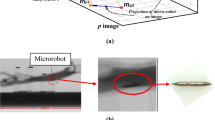Purpose
In diagnostic tomographic imaging, patient setup and scanner initialization is a manual, tedious procedure in clinical practice. A fully-automatic detection of the patient’s position, orientation, posture and pose on the patient table holds great potential for optimizing this part of the imaging workflow. We propose a markerless framework that is capable of extracting this information within seconds from either range imaging (RI) or pressure imaging (PI) data.
Methods
The proposed method is composed of three stages: First, the position and orientation of the reclined patient are determined. Second, the patient’s posture is classified. Third, based on the estimated orientation and posture, an approximate body pose is recovered by fitting an articulated model to the observed RI/PI data. Being a key issue for clinical application, our approach does not require an initialization pose.
Results
In a case study on real data from 16 subjects, the performance of the proposed system was evaluated quantitatively with a 3-D time-of-flight RI camera and a pressure sensing mattress (PI). The patient orientation was successfully determined for all subjects, independent of the modality. At the posture recognition stage, our method achieved mean classification rates of 79.4% for RI and 95.5% for PI data, respectively. Concerning the approximate body pose estimation, anatomical body landmarks were localized with an accuracy of ±5.84cm (RI) and ±5.53cm (PI).
Conclusions
The results indicate that an estimation of the patient’s position, orientation, posture and pose using RI and PI sensors, respectively, is feasible, and beneficial for optimizing the workflow in diagnostic tomographic imaging. Both modalities achieved comparable pose estimation results using different models that account for modality-specific characteristics. PI outperforms RI in discriminating between prone and supine postures due to the distinctive pressure distribution of the human body.
Similar content being viewed by others
References
Keil A, Wachinger C, Brinker G, Thesen S, Navab N (2006) Patient position detection for SAR optimization in magnetic resonance imaging. In: Proceedings of international conference on medical image computing and computer assisted intervention, pp 49–57
Wachinger C, Mateus D, Keil A, Navab N (2010) Manifold learning for patient position detection in MRI. In: Proceedings of IEEE international symposium on biomedical imaging, pp 1353–1356
Fenchel M, Thesen S, Schilling A (2008) Automatic labeling of anatomical structures in MR FastView images using a statistical atlas. In: Proceedings of international conference on medical image computing and computer assisted intervention, pp 576–584
Moeslund T, Hilton A, Krüger V (2006) A survey of advances in vision-based human motion capture and analysis. Comput Vis Image Underst 104(2–3): 90–126
Poppe R (2007) Vision-based human motion analysis: an overview. Comput Vis Image Underst 108(1–2): 4–18
Mündermann L, Corazza S, Andriacchi TP (2006) The evolution of methods for the capture of human movement leading to markerless motion capture for biomechanical applications. J Neuroeng Rehabil 3: 6
Wang CW, Hunter A (2010) Robust pose recognition of the obscured human body. Int J Comput Vis 90: 313–330
Haker M, Böhme M, Martinetz T, Barth E (2009) Self-organizing maps for pose estimation with a time-of-flight camera. In: Proceedings of DAGM dynamic 3D imaging workshop, pp 142–153
Jensen R, Paulsen R, Larsen R (2009) Analysis of gait using a treadmill and a time-of-flight camera. In: Proceedings of DAGM dynamic 3D imaging workshop, pp 154–166
Knoop S, Vacek S, Dillmann R (2009) Fusion of 2D and 3D sensor data for articulated body tracking. J Rob Auton Syst 57(3): 321–329
Zhu Y, Dariush B, Fujimura K (2008) Controlled human pose estimation from depth image streams. In: Proceedings of IEEE conference on computer vision and pattern recognition workshops, pp 1–8
Schaller C, Rohkohl C, Penne J, Stürmer M, Hornegger J (2009) Inverse C-arm positioning for interventional procedures using real-time body part detection. In: Proceedings of international conference on medical image computing and computer assisted intervention, pp 549–556
Seo KH, Oh C, Lee JJ (2004) Intelligent bed robot system: pose estimation using sensor distribution mattress. In: Proceedings of IEEE international conference on robotics and biomimetics, pp 828–832
Harada T, Mori T, Nishida Y, Yoshimi T, Sato T (1999) Body parts positions and posture estimation system based on pressure distribution image. In: Proceedings of IEEE international conference on robotics and automation, vol 2, pp 968–975
Harada T, Sato T, Mori T (2001) Pressure distribution image based human motion tracking system using skeleton and surface integration model. In: Proceedings IEEE international conference on robotics and automation, vol 4, pp 3201–3207
Kolb A, Barth E, Koch R, Larsen R (2009) Time-of-flight sensors in computer graphics. In: Eurographics, pp 119–134
Goldberg DE (1989) Genetic algorithms in search, optimization and machine learning, 1st edn. Addison-Wesley, Reading, MA
Brefeld U, Gärtner T, Scheffer T, Wrobel S (2006) Efficient co-regularised least squares regression. In: Proceedings of international conference on machine learning, ACM, pp 137–144
Author information
Authors and Affiliations
Corresponding author
Rights and permissions
About this article
Cite this article
Grimm, R., Bauer, S., Sukkau, J. et al. Markerless estimation of patient orientation, posture and pose using range and pressure imaging. Int J CARS 7, 921–929 (2012). https://doi.org/10.1007/s11548-012-0694-5
Received:
Accepted:
Published:
Issue Date:
DOI: https://doi.org/10.1007/s11548-012-0694-5




